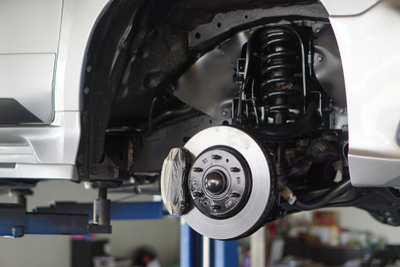A car’s suspension system supports your vehicle’s movement on the road.
From the front end suspension components to the rear suspension, it’s responsible for managing changing road conditions and ensuring that your ride is as smooth as possible.
There are different kinds of suspension systems but they are all composed of similar, basic parts like:
-
Springs: absorb impact
-
Shock absorbers (shocks): support the springs and reduce motion
-
Struts: connect wheels to the rest of the suspension system
-
Control arms: define the range of motion of wheels
-
Ball joints: enables turning and up and down motion
All of those parts working together makes for a comfortable drive, accurate handling, and reduced stress on the frame of your car.
Any damage or wear on this system can impact your driving experience and make your car less safe.
Below, we go over what happens if your car’s suspension fails or is damaged.
What Happens If A Car’s Suspension Fails?
When a car’s suspension is failing you’ll experience difficulty when steering. Depending on the circumstances, your car can suddenly drop due to suspension failure.
Worn-out springs and deep potholes can both cause your suspension system to fail, leaving you with:
-
A lower-than-normal ride
-
An unbalanced vehicle
-
Reduced ride quality
-
Uneven tire wear
Driving with your vehicle in this state can be dangerous and unpredictable. Plus, it might not be comfortable driving a car that’s leaning to one side.
Damage to the suspension system can sometimes be fixed.
However, if your suspension components have been bent due to a collision, they will most likely not be repairable and will have to be replaced with a new one.
Signs Of A Bad Suspension System
There are clear symptoms indicating that your car’s suspension system is failing. Those symptoms can range from mild to severe and they include:
Your car is pulling to one side: excess wear or damage on shock absorbers, ball joints, and control arms can cause your vehicle to lean in one direction and cause pulling.
You feel every bump: if your suspension system isn’t smoothing out bumps on the road, the struts or shock absorbers might be damaged.
The car leans back, forward, or to the side: if you feel excessive movement when cornering, braking, or accelerating, parts of your suspension system might not be working properly.
Difficulty steering: can indicate worn control arms or damage that has extended to the steering system.
Uneven tire tread: can indicate that your suspension is unbalanced and that certain parts are not working properly.

Dangers Of Driving With A Broken Suspension
When driving with a broken suspension, the first thing you’ll notice is that you have less control of your vehicle and you’ll feel less stable.
You will notice every bump on the road and might experience less traction, especially on wet roads.
You should not drive a vehicle with a broken suspension.
Even if you think you can control the car in case of an emergency, it will be a difficult task and will also end up causing more damage to your car over time.
For instance, a damaged control arm will still allow you to operate your vehicle as normal but you’ll need to be more careful when making turns as they won’t be as accurate.
Furthermore, you can’t drive with a damaged spring, especially if the damage is severe.
If the spring is completely broken, the weight of your vehicle can cause damage to wheels and tires that could result in your car becoming inoperable until the suspension is fixed.
How Much Does It Cost To Fix A Car’s Suspension?
The repair cost of a suspension system can range from $1,000 to $5,000 depending on the extent of the damage. The total cost also depends on:
-
The type of car you have
-
The complexity of the replacement
-
The number of parts you need to buy
-
Whether you purchase original or after-market parts
-
Whether your insurance company is covering any repairs
Here’s what you can expect to pay for different suspension components:
-
Pair of struts: $450 - $900
-
Pair of shocks: $250-$580
-
Coil springs: $550-$700
-
Ball joint: $200-$1,000
You’ll also need to factor in labor costs which can vary per part. You can read here to determine when car repair is a good option.
If you don’t fix your vehicle’s suspension, you’ll experience poor ride quality and further damage your car. This can be bad news if you’re planning on selling your car in the future.
Can Suspension Damage Total A Car?
For a car to be considered “totaled” its repairs need to cost more than its current value.
Because suspension repair costs are around $5,000 at most, your car will likely not be considered totaled if its only damage is the suspension system.
However, if your car is considered a clunker and its value is lower than $5,000, then a broken suspension would push it over the edge and into “totaled” territory.
Furthermore, trying to sell a car with mechanical problems will prove to be more difficult than you expect. Potential buyers will experience poor ride quality and lose interest in your vehicle.



